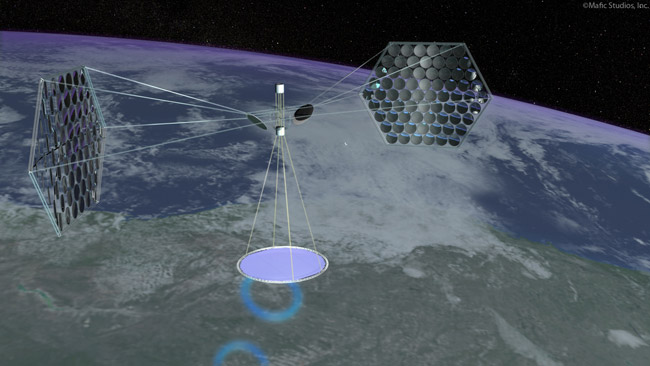Experiment Boosts Hopes for Space Solar Power

This story was updated at 3:13 p.m. EDT.
WASHINGTON— A former NASA scientist has used radio waves to transmit solar power adistance of 92 miles (148 km) between two Hawaiian islands, an achievement thathe says proves the technology exists to beam solar power from satellites backto Earth.
JohnC. Mankins demonstrated the solarpower transmission for the Discovery Channel, which paid for the four monthexperiment and will broadcast the results Friday at 9 p.m. EDT. His vision isto transmit solar power collected by orbiting satellites as large as 1,102 pounds (500 kg) to lake-sized receiver stations on Earth.
Mankins,who worked at NASA for 25 years and managed the agency's space-based solarprogram before it was disbanded, transmitted 20 watts of power between the twoislands in May. The receivers, however, were so small that less than oneone-thousandth of a percent of the power was received, Mankins said.
Theexperiment cost about $1 million, and Mankins said largerarrays could be constructed with more money.
Eachof the nine solar panels used was built to transmit about 20 watts of power,but the transmission was scaled back to two watts per panel in order to obtainU.S. Federal Aviation Administration approval for the test.
Despitethe miniscule reception on the receiving end, Mankins said the ground-basedtest proved it is possible to transmit solar power through the atmosphere.
Get the Space.com Newsletter
Breaking space news, the latest updates on rocket launches, skywatching events and more!
"Thetest was in no way fully successful," he said. "I think it showed itis possible to transmit solar power quickly and affordably."
The Discovery Channel will highlight the solar power beamingexperiment Friday, Sept. 12 in ?Discovery Project Earth: Orbital Power Plant.? ?Checklocal listings.
- Video - Beaming Solar Power From Space
- Power of the Future: 10 Ways to Run the 21st Century
- The Top 10 Emerging Environmental Technologies
Join our Space Forums to keep talking space on the latest missions, night sky and more! And if you have a news tip, correction or comment, let us know at: community@space.com.
Becky Ianotta is a former SpaceNews reporter covering space industry and policy news from 2008 to 2009. Becky earned a bachelor's degree in English/Journalism from the University of Miami. She spent five years as an editor with the Key West Citizen in Florida before joining the SpaceNews team. She later wrote for Air Force Times before taking her current position as communication director for Mother's Against Drunk Driving.









